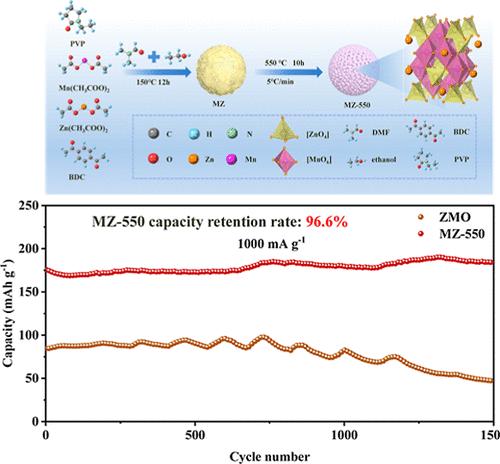基于mof的氧空位ZnMn2O4的制备及其储锌性能
IF 8.2
2区 材料科学
Q1 MATERIALS SCIENCE, MULTIDISCIPLINARY
引用次数: 0
摘要
锰基氧化物具有理论比容量高、储量丰富、工作电压高等优点,被广泛用作水性锌离子电池的正极材料。然而,它们的实际应用受到固有问题的限制,如活性物质溶解、结构坍塌或变化以及反应动力学缓慢。本研究基于金属有机骨架(MOF)合成了锌电池正极材料ZnO-ZnMn2O4 (MZ)。采用原子组成调制和缺陷工程协同策略来解决ZnMn2O4的固有问题,稳定材料结构,抑制Mn3+的歧化,降低Jahn-Teller效应。此外,该材料受益于增强的氧空位和更小的粒径,这促进了更快的反应动力学。电化学测试表明,MZ-550在100 mA g-1下具有314.5 mA h g-1的高比容量和循环稳定性,在1000 mA g-1下循环1500次后容量保持率为96.6%。此外,该材料在极端条件下表现出出色的电化学性能,在- 20°C和40°C的比容量分别为86.4 mA h g-1和331.1 mA h g-1。该研究为先进储能系统中ZIBs高性能正极材料的开发提供了见解。本文章由计算机程序翻译,如有差异,请以英文原文为准。

MOF-Based Construction of Oxygen Vacancies ZnMn2O4 for Superior Zinc Storage
Manganese-based oxides are widely used as cathode materials for aqueous zinc-ion batteries (ZIBs) due to their high theoretical specific capacity, abundant reserves, and high operating voltage. However, their practical applications are limited by inherent issues such as active material dissolution, structural collapseor changes, and slow reaction kinetics. In this study, a cathode material for zinc batteries, ZnO–ZnMn2O4 (MZ), is synthesized based on a metal–organic framework (MOF). Synergistic strategies involving atomic composition modulation and defect engineering are employed to address the inherent issues of ZnMn2O4, stabilize the material structure, inhibit the disproportionation of Mn3+, and reduce the Jahn–Teller effect. Additionally, the material benefits from enhanced oxygen vacancies and a smaller particle size, which promote faster reaction kinetics. Electrochemical tests show that MZ-550 delivers a high specific capacity of 314.5 mA h g–1 at 100 mA g–1 and cycling stability, with a capacity retention of 96.6% after 1500 cycles at 1000 mA g–1. In addition, the material demonstrates outstanding electrochemical performance under extreme conditions, with specific capacities of 86.4 mA h g–1 at −20 °C and 331.1 mA h g–1 at 40 °C. This study provides insights for the development of high-performance cathode materials for ZIBs in advanced energy storage systems.
求助全文
通过发布文献求助,成功后即可免费获取论文全文。
去求助
来源期刊

ACS Applied Materials & Interfaces
工程技术-材料科学:综合
CiteScore
16.00
自引率
6.30%
发文量
4978
审稿时长
1.8 months
期刊介绍:
ACS Applied Materials & Interfaces is a leading interdisciplinary journal that brings together chemists, engineers, physicists, and biologists to explore the development and utilization of newly-discovered materials and interfacial processes for specific applications. Our journal has experienced remarkable growth since its establishment in 2009, both in terms of the number of articles published and the impact of the research showcased. We are proud to foster a truly global community, with the majority of published articles originating from outside the United States, reflecting the rapid growth of applied research worldwide.
 求助内容:
求助内容: 应助结果提醒方式:
应助结果提醒方式:


